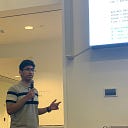Consistency beats Intensity
--
After seeing one of Shane Parrish’s tweets on qualities that outperform other qualities in the long term, I wanted to reflect on how I’d performed in 2020 with regards to whether I was a short term or long term thinker.
When we all went under lockdown in 2020, I was super excited to hit the books, enroll in dozens of courses, and cross off hundreds of to-dos. I’d even calculated the amount of free time that I would have till the summer ended and school started (turned out to be about 1500 hours), and I split up the time to read, learn different coding languages, and work on projects. Looking back at 2020, I can say that I didn’t follow the 1500 hour time division that I’d set for myself.
The mistake I made was that I was too focused on intensity and number of hours spent, rather than the number of hours spent truly focused on the task at hand. I thought that because I had so much free time due to quarantine, I should spend all of that time in a perfectly optimized way. In the first 1–2 months of quarantine, that definitely backfired for me.
In quarters two and three, I started to be more realistic with my time. Just because I have 14–15 free hours a day, every minute doesn’t need to be optimized. I let myself read different blogs, articles, and take more time for myself. I stopped doing what I’d like myself or what I wanted myself to do and started doing what I needed to do for myself.
I’m really happy with the way that I grew during Q3 and Q4. I was much more focused on singular projects instead of trying to attempt to tackle 50 things at once. I started getting more results and better deliverables, and they seemed to be coming without me trying as hard. This to me seems like an example of Mark Manson’s backward law, where intentionally trying to do less of something leads to more of it. Staying in the present and trying less to optimize every single minute led somehow led to me better using my time.
Done > Perfect
Optimizing a particular variable becomes hard when there are many values that the variable can take on. When you try and optimize 50 variables at once, there an exponentially large number of possible combinations. This goes for drug cocktails, machine learning parameters, and personal growth. Once quarantine started, I was overwhelmed with possibilities.
- What’s the best morning routine?
- What’s the best note-taking system? (Roam vs obsidian vs notion vs workflowy)
- What courses should I choose to learn from and in what order should I do them?
- Should I focus more on learning through online courses or project-based learning?
I probably wasted a significant portion of 2020 switching between different possibilities and options instead of religiously sticking to one. I don’t know if “wasted” gives justice to the benefits of exploring different options. However, I think I was exploring to the extent that I was trying to find the optimal solution–the global optimum. And I thought I could do it in months. Boy, was I wrong. In the process of trying to achieve the optimal solution, I didn’t end up basking in any local optimums.
If we stick with the machine learning analogy, I think personal growth isn’t one giant step from baseline to global optimum, but multiple steps where you end up with different local optimums. At some point, you realize that what you thought is the global optimum is merely a local one.
In 2021, I’m going to be so much more intentional with situating myself in these local optimums instead of being in a frenzy to find perfection. That’s how I’ve designed my monthly goals and deliverables. I can try and experiment with multiple variables, but there will always be one habit/goal that is non-negotiable.
